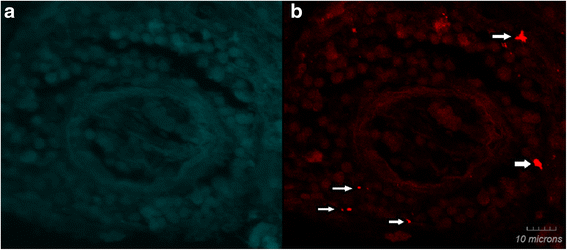Vasculitis, cerebral infarction and persistent Bartonella henselae infection in a child
- PMID: 27161220
- PMCID: PMC4862072
- DOI: 10.1186/s13071-016-1547-9
Vasculitis, cerebral infarction and persistent Bartonella henselae infection in a child
Abstract
Background: The genus Bartonella is comprised of a rapidly increasing number of pathogenic species that induce a seemingly diverse spectrum of neurological symptoms. During the 12 year period that followed the initial onset of neurological and gastrointestinal symptoms, an 11 year-old girl experienced a spectrum of neurological complaints including frequent headaches, visual and auditory hallucinations, anxiety, vision loss involving the lower left quadrant of both eyes, episodic bouts of generalized paralysis, facial palsy, chronic insomnia, seizures, dizziness, cognitive dysfunction, and memory loss. PCR assays targeting Bartonella spp. were used to test formalin-fixed, paraffin embedded brain tissue, patient blood specimens and Bartonella alpha Proteobacteria growth medium (BAPGM) enrichment blood cultures. PCR positive amplicons were sequenced directly and compared to GenBank sequences. Bartonella spp. serology was performed by indirect fluorescent antibody testing and confocal laser scanning microscopy was used to visualize B. henselae organisms in resected brain.
Results: Bartonella henselae DNA was independently PCR amplified and sequenced from the girl's right parietal lobe, surgically resected in 2000 and from a blood specimen collected in 2012. Although causation cannot be established by a case report, prior diagnostic testing resulted in findings that were either inconclusive or within normal reference ranges and no etiological diagnosis had been obtained to explain the patient's initial or progressive neurological symptoms.
Conclusions: As intravascular, intra-erythrocytic and endotheliotropic bacteria, it is possible that B. henselae initially induced a vasculitis, resulting in secondary cerebral infarction, tissue necrosis and surgical resection. Bartonella bacteremia, potentially spanning a 12-year time frame, in conjunction with the therapeutic administration of immunosuppressive drugs may have resulted in a progression and potentiation of the neurological disease that was partially reversible following antibiotic administration.
Keywords: Bartonella henselae San Antonio 2 vasculitis; Neurobartonellosis.
Figures

References
Publication types
MeSH terms
LinkOut - more resources
Full Text Sources
Other Literature Sources
Medical
Research Materials
Miscellaneous

